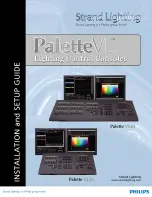
17
Tutorial
Plug your expression pedal’s standard 1/4” connector into the Expression Pedal
2.
input on the back of the TimeBender
TM
Delay.
Set the expression pedal to the minimum (heel) position.
3.
Adjust the controls on the TimeBender to get a starting sound that you like.
4.
Step forward on the expression pedal to put it into the maximum (toe) position.
5.
Adjust one or more of the delay time, voicing, mix, tone, repeats, modulation,
tempo multiplier, pattern, and key to get the sound that you like.
Move the pedal from the heel to the toe position while you’re playing and listen
6.
to the delay blend between your two settings.
When you store your changes to a memory location, both the heel and toe settings are
stored. If you don’t have an expression pedal connected when that memory location
is loaded, you’ll hear the toe position setting. To restore your expression pedal’s heel
and toe positions to match what the TimeBender controls are showing, simply step
through the memory locations until no memory location is selected; the expression
pedal’s heel and toe positions will now be reset. You can also unplug the expression
pedal and plug it back in to accomplish the same thing.
Using the Envelope Delay Type
When you use Envelope, you might notice that a short note won’t produce any audible
delays. That’s because Envelope creates delays using a completely different approach
than the other delay types. Instead of playing back a delayed version of your input
signal, Envelope “slices” up the current signal using configurable envelope shapes,
and then plays these slices back at the delay times defined by your current pattern. If
you’ve set voicings other than unison, these slices will be pitch shifted as well. Enve-
lope works best with effects that have long sustains, like most distortion effects.
Changing Envelope Shapes
When the Envelope delay type is selected, the Repeats knob controls the shape of the
envelopes applied to the input guitar signal. In the leftmost position, the envelope
has a sharp onset and a rapid decay, giving the effect of a newly plucked note. As the
Repeats knob is turned up, the envelope shape changes. It first begins to shorten until
it becomes quite percussive, then becomes longer with a more level sustain section.
Towards the end of the range the envelope has an upward ramp with a quick decay
resulting in a reverse envelope sound.
















































